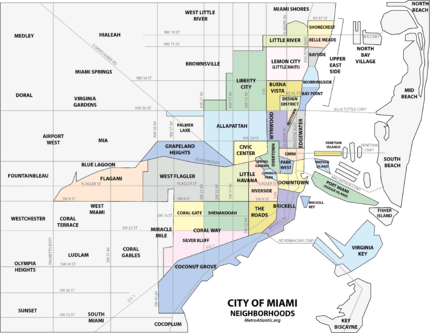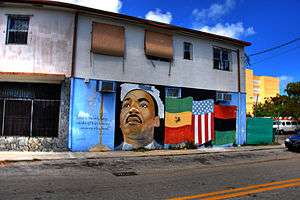Liberty City
| Liberty City | |
|---|---|
| Neighborhood of Miami | |
|
Liberty City mural | |
| Nickname(s): Model City (historic name) | |
 The Liberty City neighborhood in Miami | |
| Country |
|
| State |
|
| County | Miami-Dade County |
| City | Miami |
| Government | |
| • City of Miami Commissioner | Richard Dunn |
| • Miami-Dade Commissioners | Audrey Edmonson |
| • House of Representatives | Cynthia Stafford (D) and Daphne Campbell (D) |
| • State Senate | Larcenia Bullard (D) and Oscar Braynon (D) |
| • U.S. House | Frederica Wilson (D) |
| Elevation | 3 m (10 ft) |
| Population (2010) | |
| • Total | 19,725 |
| • Density | 3,733/km2 (9,669/sq mi) |
| Time zone | EST (UTC-05) |
| ZIP Code | 33125, 33127, 33142, 33147, 33150 |
| Area code(s) | 305, 786 |
Liberty City is a neighborhood in Miami, Florida, United States. The area is roughly bound by NW 79th Street to the north, NW 27th Avenue to the west, Northwest 54th Street to the South, and Interstate 95 to the east. The Miami neighborhood is home to one of the largest concentrations of blacks in South Florida, as of 2000 Census.[1][2] Although often referred to as "Model City" both historically and by the City of Miami government, the neighborhood is more commonly referred to as "Liberty City" by local residents.
It is serviced by the Miami Metrorail at Dr. Martin Luther King Jr. Plaza and Brownsville stations along NW 27th Avenue.
History
Once a part of the sparsely populated outskirts of northern Miami, what became Liberty City developed during the Great Depression of the 1930s when President Franklin D. Roosevelt authorized the construction of the Liberty Square housing project in 1933, the first of its kind in the Southern United States. Built as a response to the deteriorating housing conditions in densely populated and covenant-restricted slums of Overtown, construction on the initial housing project began in 1934 and opened in 1937.
Into the 1940s and 1950s, the growing Liberty City and adjacent Brownsville thrived as a middle income black American community, hosting several churches, hospitals, and community centers. The area served as home to prominent figures such as Kelsey Pharr, M. Athalie Range (the first black American elected to serve on the Miami city commission) and boxer Muhammad Ali. Although segregation laws prohibited black Americans from resting and residing in popular Miami Beach, service establishment and resorts such as the Hampton House Motel and Villas catered to and entertained the likes of notables such as Rev. Dr. Martin Luther King, Jr., Althea Gibson, and even whites such as Mickey Mantle.
Construction of Interstate 95 in Florida in Overtown and declining use of restrictive covenants in the wake of the Civil Rights Act of 1964 dramatically altered the neighborhood into the 1960s. Increasing numbers of lower income elderly and welfare-dependent families migrated to the Liberty City neighborhood following their displacement primarily from inner city Overtown, leading to large-scale black flight of middle and higher income blacks and other blacks like West Indian Americans largely to suburban areas like Florida City and Miami Gardens in southern and northern Dade County, respectively.
Crime grew prevalent in the increasingly poverty-stricken area in the immediate post-Civil Rights Movement era of the 1960s and 1970s. The ensuing problems of the poor and disenfranchised grew most apparent and notable in race riots which occurred in Liberty City in August 1968 during the Republican National Convention in Miami Beach, and in 1980 following the acquittal of police officers charged with the killing Arthur McDuffie.
The plight of inner-city black Miamians increasingly came to be highlighted in national press into the 1980s as the Hurricanes football team of the University of Miami won several national college football championships led by players recruited from the mostly black, lower income neighborhoods such as Liberty City and Overtown. National exposure continued with the popularity of nationally broadcast programs such as the NBC crime drama Miami Vice, which brought the deteriorating conditions of the area to greater prominence.
Into the 1990s and 2000s, the music grew to reflect the area with locals such as Luther Campbell of the 2 Live Crew pioneering the Miami bass genre which dominated Southern hip hop music during the decade. Other music and sports talents rose to national prominence from the area such as rappers Trina and Trick Daddy and NFL players Chad "Ocho Cinco" Johnson, and Willis McGahee.
Demographics
In 2000, Liberty City had a population of 23,009[3] and 43,054[4] residents, with 7,772 households, and 5,428 families residing in the neighborhood. The median household income was $18,809.87. The racial makeup of the neighborhood was 94.69% Black, 3.04% Hispanic or Latino of any nationality, 1.68% Other races (non-Hispanic), and 0.59% White.[3]
The zip codes for the Liberty City include 33127, 33142, 33147, and 33150. The area covers 5.968 square miles (15.46 km2). In 2000, there were 19,286 males and 23,768 females. The median age for males was 25.9 years, while the median age for females was 30.3 years. The average household size had 3.1 people, while the average family size had 3.7 members. The percentage of married-couple families (among all households) was 20.3%, while the percentage of married-couple families with children (among all households) was 9.1%, and the percentage of single-mother households (among all households) was 33.1%. The percentage of never-married males 15 years old and over was 21.9%, while the percentage of never-married females 15 years old and over was 29.7%.[4]
In 2000, 2.7% of the population spoke little to no English. The percentage of residents born in Florida was 74.5%, the percentage of people born in another U.S. state was 16.7%, and the percentage of native residents but born outside the U.S. was 0.8%, while the percentage of foreign born residents was 7.9%.[4]
Education
Miami-Dade County Public Schools operates area public schools:
Elementary schools
- Lillie C. Evans Elementary School
- Poinciana Park Elementary School
- Liberty City Elementary School
- Holmes Elementary School
- Charles R. Drew Elementary School
- Olinda Elementary School
- Orchard Villa Elementary School
- Lenora Braynon Smith Elementary School
- Kelsey L. Pharr Elementary School
- Earlington Heights Elementary School
- Shadowlawn Elementary School
Middle schools
- Brownsville Middle School
- Charles R. Drew Middle School
- Allapattah Middle School
High schools
Colleges
Libraries
Miami-Dade Public Library operates area public libraries:
- Model City Library
Transportation
The Miami Metrorail services the neighborhood at the following stations:
- Earlington Heights (Airport Expressway and West 22nd Avenue)
- Brownsville (North 52nd Street and West 27th Avenue)
- Dr. Martin Luther King Jr. Plaza (North 62nd Street/Martin Luther King Jr. Blvd and West 27th Avenue)
Notable residents
- Ian Richards (Judge)
- Wilkie D. Ferguson, Jr.
- M. Athalie Range
- Carrie P. Meek
- Luther Campbell
- Ky-mani Marley
- Darlyne Chauve
- Udonis Haslem
- Mickey Rourke
- Montel Vontavious Porter
- Trick Daddy
- Trina
- Chad Johnson, NFL wide receiver
- Bershawn Jackson
- Rakeem Cato
- Jacki-O
- Darnell Jenkins
- Betty Wright
- Marcus Forston
- Jacory Harris
- Sean Spence
- Teddy Bridgewater
- John Marks, Mayor of Tallahassee
- DJ Uncle Al
- George Jung-lived in Liberty City in 1987 which was shown in the movie Blow
- Rakeem Cato, CFL Quarterback
- Antonio Brown, NFL Receiver
See also
- Liberty City Riots
- Liberty Square
- Miami Workers Center
- Nation of Yahweh
- New Covenant Presbyterian Church of Miami
References
- ↑ "City of Miami-NET: Model City (Liberty City)". www.ci.miami.fl.us. Retrieved June 11, 2008.
- ↑ Liberty City neighborhood, detailed profile
- 1 2 "Demographics of Liberty City Miami, FL.". miamigov.com. Retrieved June 11, 2008.
- 1 2 3 "Demographics of Liberty City, Miami, FL.". city-data. Retrieved September 7, 2009.
External links
Coordinates: 25°49′54″N 80°13′29″W / 25.831801°N 80.224829°W

